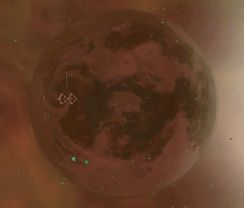
|
This wiki is closed in favour of the new wiki. Information shown is likely to be very out of date. |
Planet Weimar
| Planet Weimar | |
| Owner | |
| Location | 5F, Thuringia |
| Technical information | |
| Population | 50,000 |
| Docking | Restricted |
| Terrain | CLASSIFIED |
| Diameter | CLASSIFIED |
| Mass | CLASSIFIED |
| Temperature | CLASSIFIED |
| Escape velocity | CLASSIFIED |
Planet Weimar is a gray, young, wild and stormy world with blooming flora, famous for its massive mountain ranges, dense forests, swamp biomes and muggy climate. An unusual type of Xeno-Algae is the reason for the high concentration of Oxygen in the air, which made life possible on this planet in the first place, and provides a fertile home for a rich diversity of fauna and flora today, some of which are extremely dangerous to human life. Its inhospitable nature makes infiltration with ground vehicles impossible. Embedded within its crust, Weimar contains rich deposits of crystalline minerals deemed useful as insulation material. These provide a natural radiation protection, are impenetrable to known scanner technologies, and would also withstand orbital bombardment.
After the discovery of Weimar in 530 A.S., the Imperial Navy began with its colonisation and quickly realized Thuringia's potential for scientific discovery and technological advances after further exploration. The planet served as a staging point for the imperial exploration force during this time, as it offered a source of Oxygen, Water and Food supplies. Further investments in the expansion of the Planet's infrastructure were made shortly before the 80-Years War broke out, which changed Weimar into a fortress world. Under Empress Leicht's reign, immense efforts were made in establishing an impregnable underground city called "Festung Fensalia" for her majesty and naval forces. The city consists of a gigantic tunnel system, underground facilities and bomb shelters, connecting hidden landing paths and forest barracks at the surface, all surrounded by Weimar's most massive mountain formations. Thuringia's role during this time was mainly to serve as an easily defensible point-of-retreat with additional capacities to maintain, build, and hide a reserve fleet, while Planet Weimar provided the necessary habitation facilities for workers and officers serving the Imperial Navy. However, mistakes were made and many projects were never completed or never came to use before the war ended in 668 A.S.. Due to the Rheinland economy's subsequent collapse, the military could no longer fund the maintenance costs of the Thuringia project, leaving the whole system abandoned for centuries.
When the nomads began to infiltrate Rheinland prior to 800 A.S., abandoned facilities in Thuringia were re-established by the infested military forces, and they prepared for their march into the Sigmas from there. Hidden from the public eye, Valhalla and Schatten were both used for necessary maintenance of the Nomad fleet during this time. The destruction of the Westerwald facility, however, did not stop the Nomads from invading Kusari. Shortly after the Nomad War, a small wing consisting of Marinenachrichtendienst elite pilots began to fight remaining Nomad forces within Thuringia in a final battle. MND and the military made use of Konigsberg as an operational center to launch attacks against the remnants of the Nomad fleet in Rheinland. Nomad remains, such as host bodies and nomad technologies, were brought to Weimar's underground laboratories for further examinations. This continues even today. Top scientists and officers of the MND reside on Weimar. Its population is estimated to be about 50.000 people. Everything else is highly classified, for reasons of national security. Docking is restricted to the most trusted officers amongst the ranks of the MND and Rheinland Military.
Fensalia serves as headquarter of the MND today, hiding dozens of shelters and underground facilities. This includes "Festung Fensalia," once the emperor's secret residence, today the command center of the MND.
Storms afflict the polar regions regularly, preventing extensive ground operations in those areas. The polar region is known by the MND as a treasure trove for ancient alien ruins and artifacts. Further excavations revealed what remained undiscovered in previous centuries: several ancient, alien sites across the polar landscape, including what could be the remains of an enormous Daam K'Vosh temple at the North Pole. But the polar region's almost impassable terrain and extreme weather make excavations very difficult, leaving the majority of the ruins still unexplored. Weimar's underground is still largely unexplored today. Thousands of ancient bunkers and underground structures are evidence of the ambitious projects the Rheinland empire constructed.
Missions Offered
| [show]Spoiler: |
|---|
Bribes Offered
| [show]Spoiler: |
|---|
Commodities
| Exports |
| Imports |
Ships
|
|
